The Independent's journalism is supported by our readers. When you purchase through links on our site, we may earn commission.
How ultra-processed foods took over family mealtimes – and the recipes you need to fight back
UPFs have infiltrated almost every corner of modern family life and, in the UK, 66 per cent of adolescents’ daily intake now comes from highly processed food. But there are ways to get critical nutrients into your diet without banning indulgence or turning dinner into a war zone, Rob Hobson tells Hannah Twiggs

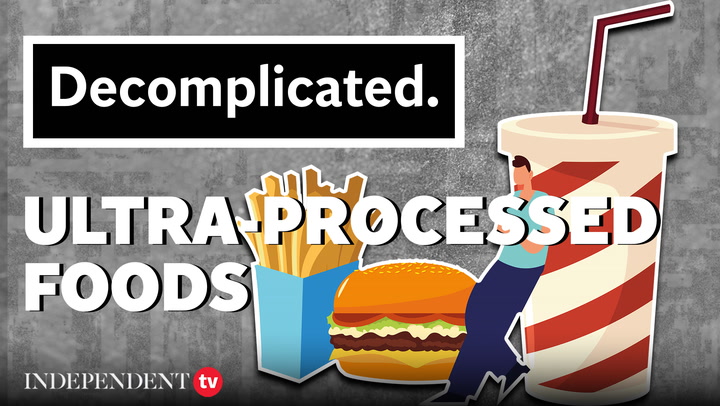
Family mealtimes have become ground zero in the battle against ultra-processed foods (UPFs). From the sugary cereals that start the day to the endless snack options vying for attention after school, these foods are reshaping the way families eat – and not for the better. For Rob Hobson, award-winning nutritionist and author, this isn’t just a concern; it’s a call to action.
After the success of his book last year, Unprocess Your Life, which brought the conversation around UPFs into the mainstream and added to a growing body of popular literature (including works by the godfather of the anti-UPFs movement, Tim Spector), Hobson has turned his attention to the bigger picture. The clue is in the name. His new book, Unprocess Your Family Life, is aimed squarely at families – particularly tweens and teens – who are most vulnerable to the allure of these highly engineered foods.
“During my career, I have worked with families, schools and charities, and supported my own family members through healthier habits,” says Hobson. “But there’s been a gap when it comes to teens and tweens.” With 66 per cent of adolescents’ daily intake now coming from UPFs in the UK, he says, the stakes couldn’t be higher. “They’re at such a pivotal stage in their development, both physically and mentally, but they’re often left out of the conversation when it comes to diet and health.”
At the core of the issue is the insidious design of UPFs. Energy-dense and nutrient-poor, they’re engineered to be hyper-palatable – a dangerous trifecta of fat, sugar and salt. They’re also aggressively marketed, making them not just convenient but unavoidable. For families, particularly those with picky, stubborn teenagers, this presents a double-edged sword.
“UPFs can disrupt taste preferences, making natural, minimally processed foods less appealing,” Hobson explains, and adolescents are especially vulnerable. The long-term implications? “Their overconsumption is linked to numerous health risks, including obesity, type 2 diabetes, heart disease and even mental health challenges.”
“Teens and tweens are navigating a tricky food environment,” he says. “They’re surrounded by peer pressure, bombarded with messages on social media, and starting to enjoy the independence that comes with their age. At the same time, UPFs are convenient, affordable and aggressively marketed directly at them.” Adolescence is a defining moment, when lifelong habits are forged. Hobson’s goal isn’t to banish indulgence but to empower young people to take ownership of their eating habits, “helping them make better choices without overwhelming them or making food feel like a battleground.”
That 66 per cent isn’t just a hyperbolic statistic; reliance on UPFs means young people, especially young girls, are missing out on the critical nutrients they need during this pivotal stage of life. Iron, calcium, zinc, vitamin D and magnesium “are crucial for growth, bone health, brain development and overall wellbeing,” Hobson explains. “Iron supports healthy red blood cells and cognitive function, while calcium and vitamin D are essential for bone strength and development.”
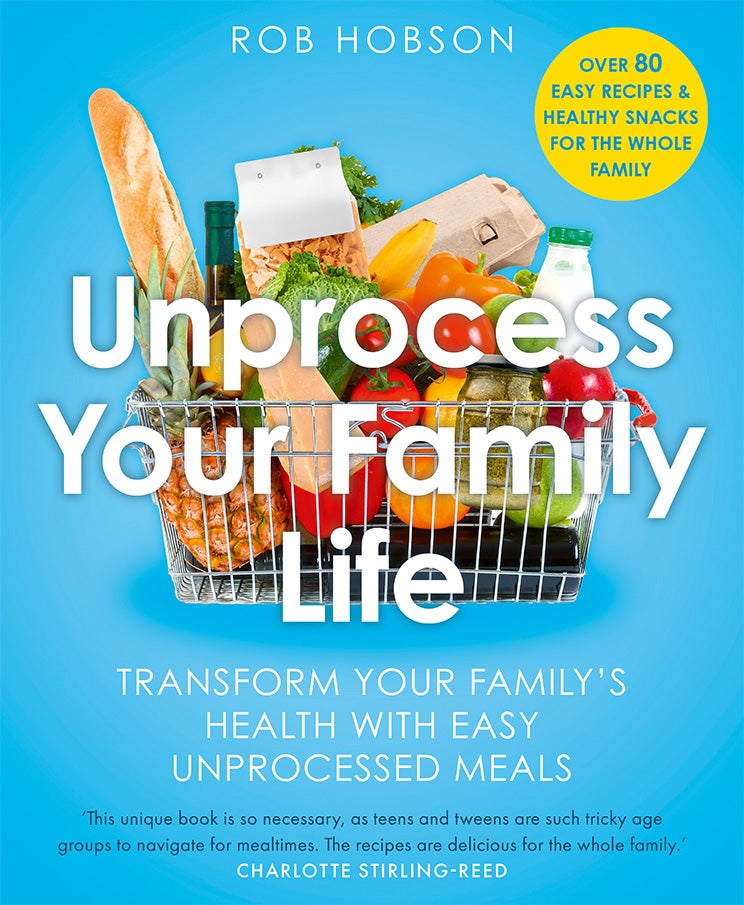
Addressing these nutritional gaps doesn’t mean chasing perfection – practical fixes in the book include adding spinach to smoothies, lentil wraps paired with vitamin C-rich vegetables or a Thai-inspired salmon traybake.
Hobson also advocates for a balanced approach that families can realistically maintain. This is where his philosophy of the 80/20 rule comes in – where, simply, you eat healthy foods 80 per cent of the time and allow yourself to enjoy less healthy foods for the remaining 20. But don’t get bogged down in the maths. “The 80/20 rule isn’t about strict percentages but rather prioritising unprocessed and minimally processed foods for most meals while allowing for the occasional indulgence,” Hobson explains.
It’s about emphasising that eating healthier doesn’t mean deprivation or giving up your favourite foods entirely. And when UPFs are part of a meal (because sometimes, “life happens”), “focus on making the best choices you can within your circumstances”, like opting for nutrient-dense UPFs such as wholemeal breads or cereals with added fibre, and balance them with whole foods. “If you’re serving shop-bought pizza or a ready meal, add a large side salad or extra vegetables.”
Of course, getting there isn’t without its hurdles. Hobson is acutely aware of the challenges families face – tight budgets, lack of time, picky eaters and the relentless pull of convenience. His book is a treasure trove of strategies to overcome these barriers.
One of the easiest places to start? Focus on easy, incremental changes. “Gradually transition from white bread, rice and pasta to wholemeal or mixed alternatives. Incorporate lentils or beans into family favourites like spaghetti bolognese to increase fibre content without drastically altering the dish.” The list goes on, but these small shifts not only improve nutrition while keeping meals familiar and enjoyable, but ease the kids into a new way of eating.

Budget is another sticking point for many. Hobson is quick to challenge the idea that healthy eating has to cost a fortune. “Eating healthily on a budget is entirely possible with a little planning,” Hobson says. He points to proteins and carbohydrates as two areas where you can make a big impact without overspending. “Tinned fish, eggs, lentils and beans are excellent budget-friendly protein sources,” he says. And, “for carbohydrates, staples like oats, potatoes and wholemeal pasta or rice are inexpensive, filling and highly adaptable”.
He says shopping smartly will “ensure that you’re making the most of your ingredients and reducing food waste”, whether that means opting for “wonky” veg, frozen fruit or buying in bulk.
Weak spots in the day – those moments when families are most likely to reach for UPFs – are another focus of the book. Breakfast and after-school snacks often fall victim to time pressures, but Hobson offers practical solutions. “I suggest having on-the-go nutritious choices like breakfast burritos, healthy egg muffins or pre-prepared smoothie mixes”. Having healthy snacks like energy squares or flavoured popcorn to hand when the kids get home from school, hunger strikes and time is short will quell the temptation to reach for ultra-processed foods.
Batch cooking is Hobson’s ace in the hole, but it’s not just about filling the freezer. “To keep things interesting and avoid fatigue, I recommend the ‘one dish, five ways’ approach,” he says. It’s a simple hack. For example, “a chicken curry can be transformed in multiple ways: serve it with rice, fold it into a wrap with mango chutney, thin it out with coconut milk for a broth, top it with sweet potato mash to create a pie, or add noodles for a hearty twist.” Preparing lunches in advance with ingredients like cooked chicken, tinned pulses or rice and pasta salads are quick and cost-effective alternatives to soggy supermarket sandwiches filled with who knows what.
Quick tips to ‘unprocess’ your family life
Start small: Swap sugary cereals for homemade options like banana porridge or overnight oats. Gradually mix wholemeal and white rice or pasta to ease the transition.
Plan ahead: Batch-cook curries, soups or pasta sauces and freeze them for busy nights. Prep smoothie bags, egg muffins or energy balls for quick breakfasts and snacks.
Make it fun: Involve kids in the kitchen. Younger ones can help with safe tasks, while teens can experiment with trendy dishes like sushi bowls or homemade noodle pots.
Budget smartly: Focus on affordable staples like lentils, beans, oats and frozen vegetables. Explore ‘wonky’ produce and bulk-buy for long-term savings.
Recreate favourites: Try healthier homemade versions of shop-bought classics like chocolate spread, pizza or chicken nuggets. Keep it simple but delicious.
Balance is key: Follow the 80/20 rule – prioritise unprocessed foods most of the time, but enjoy occasional treats without guilt.
Leverage social media: Encourage teens to follow creators who share healthy, relatable recipes. Cook viral dishes together and make them your own.
Target weak spots: Stock up on easy, nutritious options for the times you’re most likely to rely on UPFs, like after school or during a busy workweek.
Social media, often a nutritional minefield, also features prominently in Hobson’s approach. Platforms like TikTok, while responsible for some questionable food trends, can also inspire better habits. “Social media plays a huge role in teenagers’ lives, so rather than trying to fight its influence, it’s often more effective to work with it,” Hobson advises. “Teenagers often trust influencers and food content creators, so encourage them to follow those who share relatable, healthy recipes and advice.”
Encourage them to explore food trends or dishes they see online – but in a healthier way. “If they’re interested in trendy foods like poke bowls or Korean BBQ chicken, teach them how to make these dishes at home using fresh, minimally processed ingredients.”
For Hobson, family involvement is key. Cooking isn’t just about getting meals on the table – it’s an opportunity to bond, teach and empower. “Cooking together not only builds skills but also strengthens family bonds and increases their willingness to try new foods,” says Hobson. “Involving children and teenagers in planning and preparing meals will foster a sense of ownership and interest.”
And, for teenagers resistant to change, “frame healthier eating as a way to achieve personal goals. For teenagers, link food choices to their interests, such as improving athletic performance, maintaining a clear complexion or boosting energy levels,” and so on.
At its core, Unprocess Your Family Life isn’t about perfection. “There is not one size fits all to help families achieve a better diet,” he says. “I’ve learnt that family food choices are deeply emotional and shaped by routines, traditions and stress – not just nutrition. Parents often feel pressure to ‘get it right’, which can lead to frustrations when kids resist change.”
Instead, he continues, “It’s about balance, progress and enjoying the journey – not about being perfect”. And for a world hooked on convenience, that’s a call worth heeding.
Baked spaghetti with pork mince and green olives
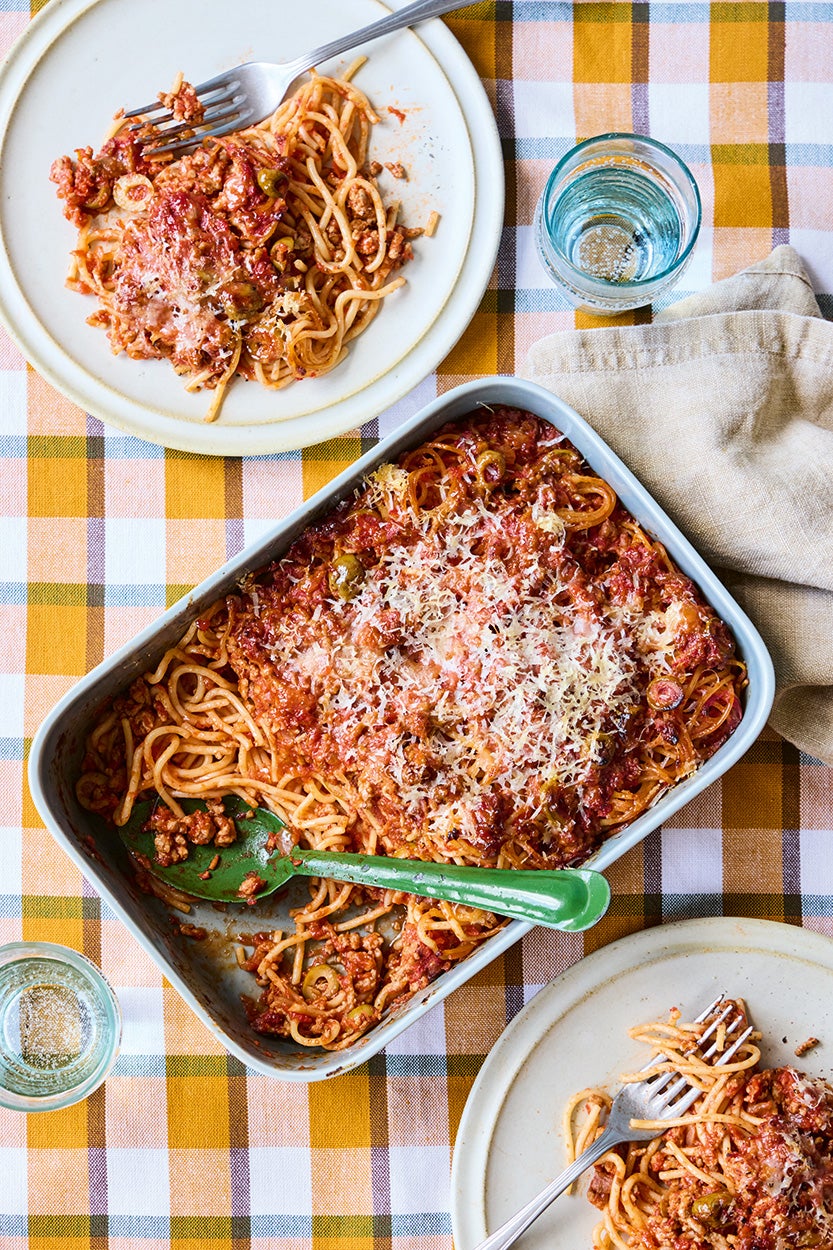
“Baked pasta was one of my favourite dishes growing up. There’s something incredibly satisfying about coming home to a baked pasta bolognese with melted cheese – especially those crunchy bits of pasta – after a long day at school or my Saturday job at a busy café.
“This dish is a twist on my mum’s baked spaghetti bolognese, with added parmesan and olives to make it even more savoury and delicious. The best part? The leftovers are just as good! Simply fry them in a pan with a little oil and sprinkle over some more parmesan.
“It’s an easy and tasty way for your teenagers to cook for themselves when you’re busy or when they want something substantial to snack on between meals.”
Serves: 4
Ingredients:
1 tbsp extra virgin olive oil
1 large onion, finely diced
2 garlic cloves, finely chopped
500g lean pork mince (5 per cent fat)
1 tbsp plain wholemeal flour
350ml fresh chicken stock
2 x 400g tins chopped tomatoes
1 tbsp tomato purée
½ tsp grated nutmeg
1 tsp dried oregano
60g pitted green olives, sliced
400g white or wholemeal spaghetti
4 tbsp finely grated parmesan cheese
Sea salt
Notes: Leftovers are just as tasty the next day – simply fry in a large pan until heated through. You can also reheat in the oven or air fryer.
You can replace the pork with chicken or turkey mince – thigh mince will give you the best flavour.
Method:
1. Heat the oil in a large non-stick frying pan over a medium heat. Once hot, add the onion and fry for 5-6 minutes until softened. Add the garlic and cook for a further minute.
2. Add the pork and cook for 5-6 minutes until browned, breaking it up with the back of a spatula as it cooks.
3. Sprinkle the flour over the pork and cook for a further 3 minutes. Add 100ml of the chicken stock and let it boil for 1 minute, then add the tomatoes, tomato purée, nutmeg, oregano, olives and remaining stock. Simmer gently for 30 minutes, stirring occasionally. Depending on the saltiness of your stock, you may need to add a little salt.
4. Just before the sauce is ready, preheat the oven to 180C/160C fan/gas 4 and lightly oil a large baking dish.
5. Cook the pasta in a large saucepan of boiling water until just al dente, then drain. Tip into the pan of sauce and combine well.
6. Transfer the pasta mixture to the baking dish and sprinkle with the parmesan. Bake in the oven for 30-35 minutes until the top is crisp. Serve with a salad.
Paneer tikka kebabs with mango salsa
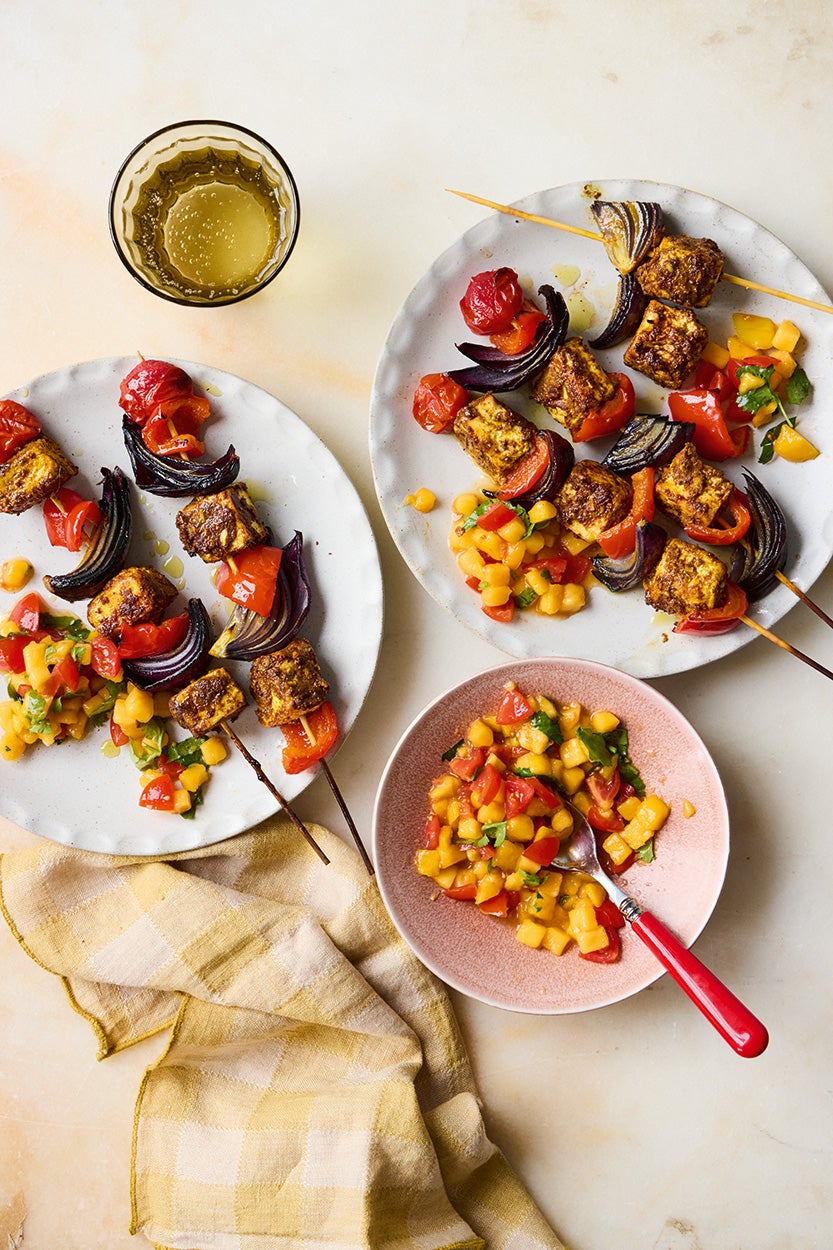
“Paneer is a fantastic, budget-friendly source of protein that’s often overlooked. Its texture is perfect for skewers, and it absorbs other flavours brilliantly.
“This tandoori marinade adds the perfect touch without the extra salt found in many shop-bought sauces and pastes, while the sweet salsa makes the dish appealing to younger children. Making your own fruit salsas and marinades also helps cut out added sugars from manufactured versions.”
Makes: 8 small skewers
Ingredients:
2 x 225g blocks of paneer
Thumb-sized piece of ginger, peeled and grated
2 large garlic cloves, finely chopped
Juice of 1 lime
2 tbsp Greek-style yoghurt
1 tbsp smoked paprika
2 tbsp garam masala
1 tsp ground turmeric
½ tsp cayenne pepper (optional)
1 large red pepper, cut into 16 pieces
2 small red onions, each cut into 8 segments
8 cherry tomatoes
2 tsp extra virgin olive oil
Sea salt
For the salsa:
1 ripe mango, diced
8 cherry tomatoes, diced
Small handful of coriander, finely chopped
Juice of 1 lime
Notes: Make a larger batch of spice mix to use with tofu, chicken and fish.
The paneer and salsa can be turned into a delicious wrap the next day. For an extra flavour boost, spread a mixture of yoghurt, grated cucumber and mint over the wrap first.
Method:
1. Soak 8 small wooden skewers in water until needed and line a baking tray with foil.
2. Cut each block of paneer in half lengthways, then cut each half into 6 cubes to give you 24 pieces in total.
3. In a large bowl, combine the ginger, garlic, lime juice, yoghurt and spices. Add the paneer and a good pinch of salt, then gently toss in the mixture to cover. Chill for 1 hour.
4. Preheat the grill to high. Add the chopped vegetables to a bowl and add the olive oil, then toss to coat.
5. Thread the marinated paneer onto the skewers, alternating with red pepper, paneer, onion, then finish with a cherry tomato. Place the skewers on the prepared baking tray.
6. Place the tray under the grill and cook for about 12 minutes, turning a few times while cooking, until the vegetables are softened and slightly charred.
7. While the skewers are grilling, combine all the salsa ingredients in a bowl.
8. Serve the skewers with the salsa, salad leaves and basmati rice or sesame seed flour wraps.
Chocolate and banana everyday loaf cake
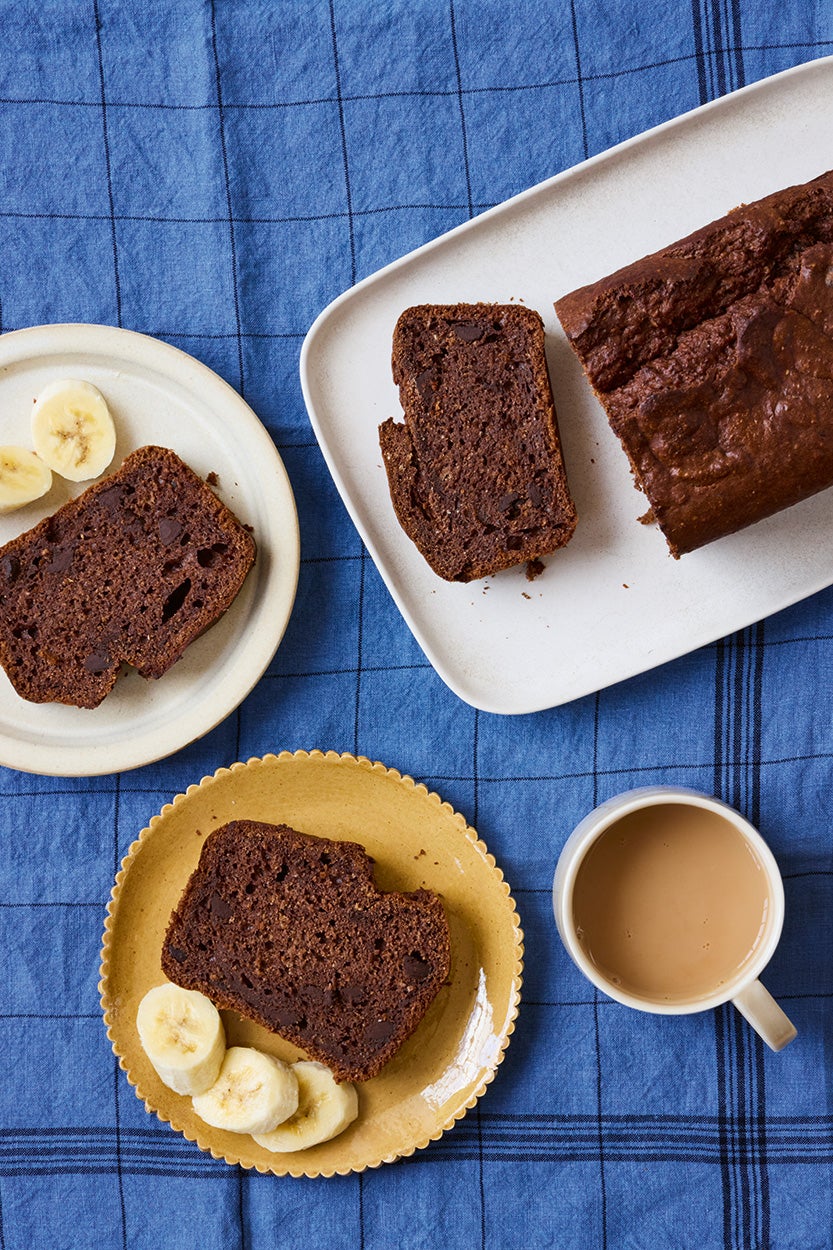
“Baking a homemade loaf cake every week ensures there’s always a tasty snack for teenagers when they get home from school, and who doesn’t love chocolate cake?
“However, many shop-bought options have long shelf lives and contain ingredients you would never have in your kitchen cupboard, such as the emulsifier sodium stearoyl-2- lactylate and processing aids like triethyl citrate and microcrystalline cellulose.
“While it’s not entirely clear if these additives are harmful, they definitely aren’t necessary for this delicious chocolate cake! Keep it simple and homemade for a healthier, tastier treat.”
Serves: 8
Ingredients:
125g wholemeal flour
125g plain flour
2 tbsp unsweetened cocoa powder
1 tsp baking powder
½ tsp bicarbonate of soda
Pinch of fine salt
3 large, very ripe bananas
2 eggs, beaten
100g coconut oil, melted
2 tbsp honey
60g dark chocolate (70-85 per cent cocoa solids), chopped into small chunks
Notes: If your bananas are not ripe, poke the skin of the banana with a fork a few times and place them in the microwave for 30 seconds. Let them cool slightly and check for softness. Microwave for another 30 seconds if you need it softer.
You could swap the chocolate chunks for lightly crushed hazelnuts.
Method:
1. Preheat the oven to 190C/170C fan/gas 5. Grease and line a 900g loaf tin with non-stick parchment paper.
2. Combine the dry ingredients in a large bowl. Peel the bananas and blend in a food processor until mashed. Add the eggs, coconut oil and honey and blend again until smooth.
3. Pour the banana mixture into the bowl with the dry ingredients and fold lightly to combine. Gently fold in the chocolate chunks.
4. Pour the batter into the prepared loaf tin and bake in the oven for 45 minutes, or until a knife inserted into the centre comes out clean.
5. Let the cake cool in the tin for 10 minutes, then transfer to a wire rack to cool completely.
6. Enjoy the cake on its own or with slices of banana.
Recipes from ‘Unprocess Your Family Life’ by Rob Hobson (Thorsons, £18.99). You can buy the book here



Join our commenting forum
Join thought-provoking conversations, follow other Independent readers and see their replies
Comments